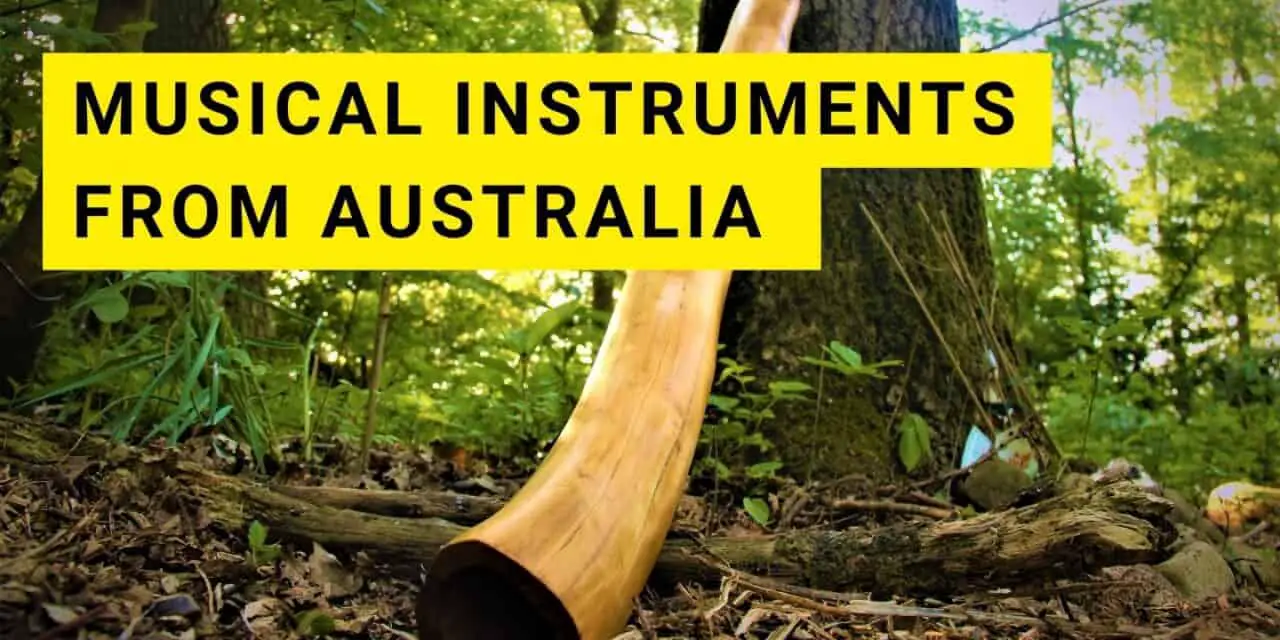Today we’ll take you on an audio journey through the Land Down Under as we explore the various musical instruments that are popular in that part of the world.
Australia, a land of rich and diverse cultures, has given birth to an array of musical instruments as unique as the continent itself.
From the iconic Didgeridoo echoing in the outback to the rhythm of the Wobble Board resonating on city streets, each instrument tells a story of tradition, innovation, and the enduring spirit of Australian music.
Didgeridoo
The Australian Aboriginal people developed the Didgeridoo – which is a wind instrument that stands as a powerful symbol of Aboriginal culture.
Constructed traditionally from eucalyptus branches hollowed out by termites, this simple wooden tube blown with the lips produces a resonant, drone-like sound that’s deeply connected to the storytelling, ceremonial practices, and spiritual beliefs of Indigenous Australians.
Every note played on a Didgeridoo echoes with thousands of years of cultural heritage, making it a compelling testament to Australia’s rich musical landscape.
The Didgeridoo is one of the most iconic names when it comes to Australian Aboriginal musical instruments.
Clapsticks
Clapsticks, or bilma, are a pair of sticks traditionally made from hardwood, tapped together to maintain rhythm in Aboriginal indigenous music.
They serve not only as percussive accompaniment to the Didgeridoo and vocals, but also carry cultural significance as they’re used in ceremonial dances and storytelling within Indigenous Australia.
Their crisp, resonant clapping sound forms the heartbeat of many traditional Aboriginal songs, connecting the music to the pulsating rhythm of the Australian landscape.
Bull-roarer
The Bull-roarer, or murrawirri, is an ancient musical instrument consisting of a simple wooden slat whirled in a circle to a cord. When twirled overhead, it creates a humming sound, thought to communicate with spiritual forces in Aboriginal culture.
The pulsating low-pitched roar of the Bull-roarer resonates with the mystic spirit of the Western Australia outback, echoing messages of the past into the present.
Gum Leaf
The Gum Leaf, as the name suggests, is literally a leaf from a gum tree used as a wind instrument. The Gum Leaf is placed against the lips and blown to create a range of melodic sounds, from high, clear notes to deeper, harmonic tunes. While it may seem simple, playing the Gum Leaf requires skill and subtlety, and it holds a cherished place in Aboriginal music.
The Guim Leaf holds as a reminder of the ingenuity of traditional musicians, making music from the very heart of nature.
Wobble Board
The Wobble Board is an innovative instrument made popular by Australian musician Rolf Harris. It’s typically a large rectangular piece of wood, plastic, or metal, which is played by wobbling it back and forth to create a rhythmic, ‘warbling’ sound.
This distinct sound has been used to add a unique percussive layer to a wide array of music styles, embodying the playful spirit of Australian music innovation.
Jaw Harp
Also known as a mouth harp or juice harp, the Jaw Harp is a small musical instrument that’s played by placing it in the performer’s mouth and plucking a metal or bamboo reed. It can produce a wide range of intriguing sounds, from twangy rhythmic patterns to melody lines, making it a versatile addition to the Australian music scene. It’s small, portable, and personable – much like a musical conversation between the player and the listener.
Stomp Box
The Stomp Box is a percussion instrument that’s often used in Australian folk and contemporary music. It’s essentially a small wooden box that’s stomped on with the foot to create a deep, resonating beat.
The sound resembles that of a kick drum, providing a rhythmic backbone to any musical performance.
The Stomp Box embodies the resourceful, do-it-yourself spirit of Australian musicians, turning an ordinary object into a compelling musical instrument, and is now used today in many settings for world music.
Rainmaker
The Rainmaker, or Rain Stick, is a ceremonial instrument that produces sounds mimicking rain. Typically a long, hollow tube filled with small pebbles or beans, when tilted, it creates a soothing sound akin to falling rain. It’s often used in storytelling and music to invoke the atmosphere of the Australian landscape, connecting listeners to the beauty and power of nature with every drop.
Lagerphone
This fun and eccentric instrument embodies Australian creativity. The Lagerphone is typically a pole with bottle caps loosely nailed to it, which jingle when the pole is tapped on the ground or shaken. Sometimes, there’s a boot attached to the bottom, a nod to its folk roots. The Lagerphone’s charm lies in its simplicity and its ability to create a celebratory, rhythmic backdrop to folk songs and bush dances, making every performance a foot-tapping experience.
Boomerang
The Boomerang, while primarily a hunting tool of Aboriginal Australians, also plays a musical role in traditional ceremonies. When clapped together or against a wooden soundboard, they produce a rhythmic sound that accompanies the Didgeridoo and Clapsticks. The Boomerang’s dual role as a musical instrument and an emblem of survival showcases the profound connection between daily life and music in Aboriginal cultures.
Yidaki
The Yidaki, another term for the Didgeridoo in certain Aboriginal languages, is a wind instrument with deep spiritual and cultural significance. It’s known for its mesmerizing, resonant sound that can range from a soft whisper to a powerful roar. The Yidaki is often central to ceremonial songs and dances, recounting ancient tales and connecting the past with the present through the vibrancy of sound.
Maton Guitar
A Maton is a type of acoustic guitar that’s proudly Australian-made. Renowned for their excellent sound quality and craftsmanship, Maton Guitars have been embraced by Australian musicians across diverse genres. From folk to rock to country music, these guitars add a touch of Australian pride to any tune, encapsulating the nation’s passion for music and innovation.
Button Accordion
The Button Accordion, sometimes referred to as a squeezebox, is a mainstay in various global music traditions, including Australia’s folk scene. This instrument is a type of accordion with buttons instead of piano-style keys. With its distinctive, rich sound, it’s used to infuse lively, rhythmic energy into performances, often driving jigs, reels, and waltzes that invite listeners to dance along. It’s a testament to Australia’s multicultural music tapestry, weaving together global influences into a unique sound.
Bush Bass
The Bush Bass is a homegrown Australian instrument, often constructed from items like packing cases or tea chests. With a broom handle and a wire or gut string attached, it’s played by tugging the string while altering tension to create a captivating, deep sound. Though it may appear rudimentary, the Bush Bass carries the resonance and soul of Australian bush bands, amplifying the resourceful spirit and creative spark of Aussie musicians.
Iron Bark Flute
The Iron Bark Flute is a traditional wind instrument made from the wood of the Australian Ironbark tree. The crafting process involves hollowing out a branch and creating finger holes to control pitch and melody. The resulting sound is haunting and beautiful, echoing the rhythms and melodies of the Australian bush. It’s a remarkable demonstration of how the Australian landscape and traditional music practices are interwoven, producing instruments that are as much a part of the land as the musicians who play them.
Australian Musical Instruments Found in Traditional Aboriginal Music
The Australian Aboriginal culture, one of the oldest surviving cultures in the world, presents a rich tapestry of musical traditions, integral to ceremonial rituals, storytelling, and everyday life. A host of unique instruments, each with its distinct voice, contribute to this timeless harmony.
Firstly, the Didgeridoo stands as a symbol of Aboriginal music. Made from limbs of eucalyptus trees naturally hollowed by termites, this wind instrument’s droning sound sets the rhythm for many traditional ceremonies.
Then we have the Clapsticks, which are wooden percussion instruments typically used to maintain rhythm during vocal chants and Didgeridoo performances. These sticks, often ornately decorated, serve as the heartbeat of many Aboriginal songs.
The Bullroarer also finds its place in sacred ceremonies. This simple yet powerful instrument consists of a wooden slat whirled around on the end of a cord, producing a unique, resonating hum. The Bullroarer’s sound is believed to communicate with spiritual beings.
The Boomerang, besides being a hunting tool, doubles as a musical instrument. When clapped together or against a wooden soundboard, Boomerangs provide rhythmic accompaniment, turning an everyday object into a source of music.
Lastly, the Iron Bark Flute, crafted from the Ironbark tree, creates haunting melodies. These traditional flutes, deeply rooted in the land, bring to life the sounds of the Australian bush in every performance.
Each of these instruments, in its unique way, paints an auditory portrait of Australia’s deep-rooted Aboriginal traditions, adding depth to the timeless melody of this ancient culture.
Australia is Home to Many Incredible Musical Instruments
As we conclude our tuneful journey, we can see how Australia’s unique musical instruments reflect its vibrant cultural landscape. These instruments, whether crafted from the woods of the Outback, forged from city scraps, or influenced by a global medley of sounds, weave a melody that is distinctly Australian.
They embody the resilience, creativity, and harmony of a land that thrives on diversity and unity. So next time you listen to the deep drone of a Didgeridoo or the rhythmic shake of a Lagerphone, remember, you’re not just hearing music, you’re experiencing a piece of Australia’s living, breathing soul.
So, keep your ears tuned for the sounds from the Land Down Under, because Australia’s music story is ever-evolving, just like its people.






